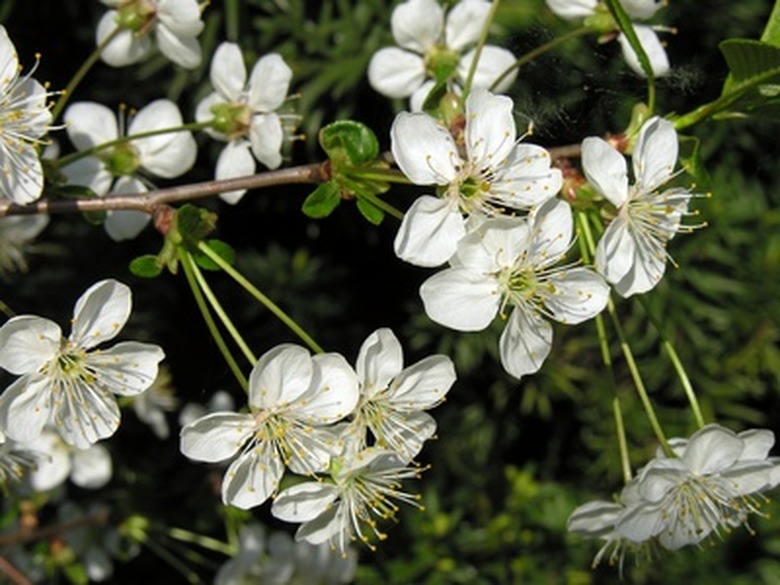Flowering Trees In Michigan
Michigan's flowering trees provide solutions to a variety of landscaping problems. Because they are native to the state, they've adapted to a host of environments from wet, deep shade to dry soil and full sun. Available in a range of heights and forms, they provide spring bloom, summer and fall fruits and foliage, and wildlife sustenance and shelter. Many Michigan flowering trees are available at native plant nurseries.
Striped Maple
Striped maple (acer pensylvanicum) is a gracefully arching 20 to 40-foot tree noticeable for its white-striped green bark. While the stripes fade with age, all striped maples have showy clusters of drooping lime-green flowers and brilliant yellow autumn foliage. Female trees produce winged seedpods called samaras. The bark of young trees adds interest to Michigan's winter landscapes and provides food for deer, rabbits and other wildlife.
- Michigan's flowering trees provide solutions to a variety of landscaping problems.
- While the stripes fade with age, all striped maples have showy clusters of drooping lime-green flowers and brilliant yellow autumn foliage.
Wild striped maples grow as understory trees in Michigan's forests. Cultivars are available at nurseries. Plant them in partly shady to shady locations with moist, well-drained acidic soil. They seldom need additional watering.
American Plum
A member of the rose family, American plum (prunus Americana) is a small–up to 35 feet–densely branched tree. Fragrant clusters of white flowers cover its wide crown during April and May. American plum produces delicious deep red fruit in August and September.
- Wild striped maples grow as understory trees in Michigan's forests.
The ripe fruit may be eaten right off the trees or used in preserves and pies. The dried plums make tasty fruit leather. The tree's autumn leaves range from light yellow to brilliant red. American plum's spreading root system makes it highly effective for erosion control. Thickets of trees provide wildlife cover.
Growing wild along streams and at forest edges, American plum does well in sun, partial shade and full shade. Plant cultivated varieties in rich, loamy well-drained soil with neutral pH. While the trees' fruit is not a favorite of most birds, the Lady Bird Johnson Wildflower Center says their flower nectar attracts hummingbirds and butterflies.
- The ripe fruit may be eaten right off the trees or used in preserves and pies.
- Plant cultivated varieties in rich, loamy well-drained soil with neutral pH.
- While the trees' fruit is not a favorite of most birds, the Lady Bird Johnson Wildflower Center says their flower nectar attracts hummingbirds and butterflies.
American Mountain Ash
Another member of the rose family, American mountain ash (sorbus Americana) is ideal for small spaces because it seldom exceeds 20 feet. Its narrow crown bears flat early-summer clusters of small white flowers followed by brilliant red berries attractive to birds. Leaves on red stalks become yellow-orange in fall.
Wild mountain ash grows in Michigan's open areas. It likes moist, cool growing conditions with acid soil but tolerates sun, partial shade and shade. It performs best at high elevations. Protect the bark of young trees from winter-browsing wildlife.
- Another member of the rose family, American mountain ash (sorbus Americana) is ideal for small spaces because it seldom exceeds 20 feet.
- Wild mountain ash grows in Michigan's open areas.
